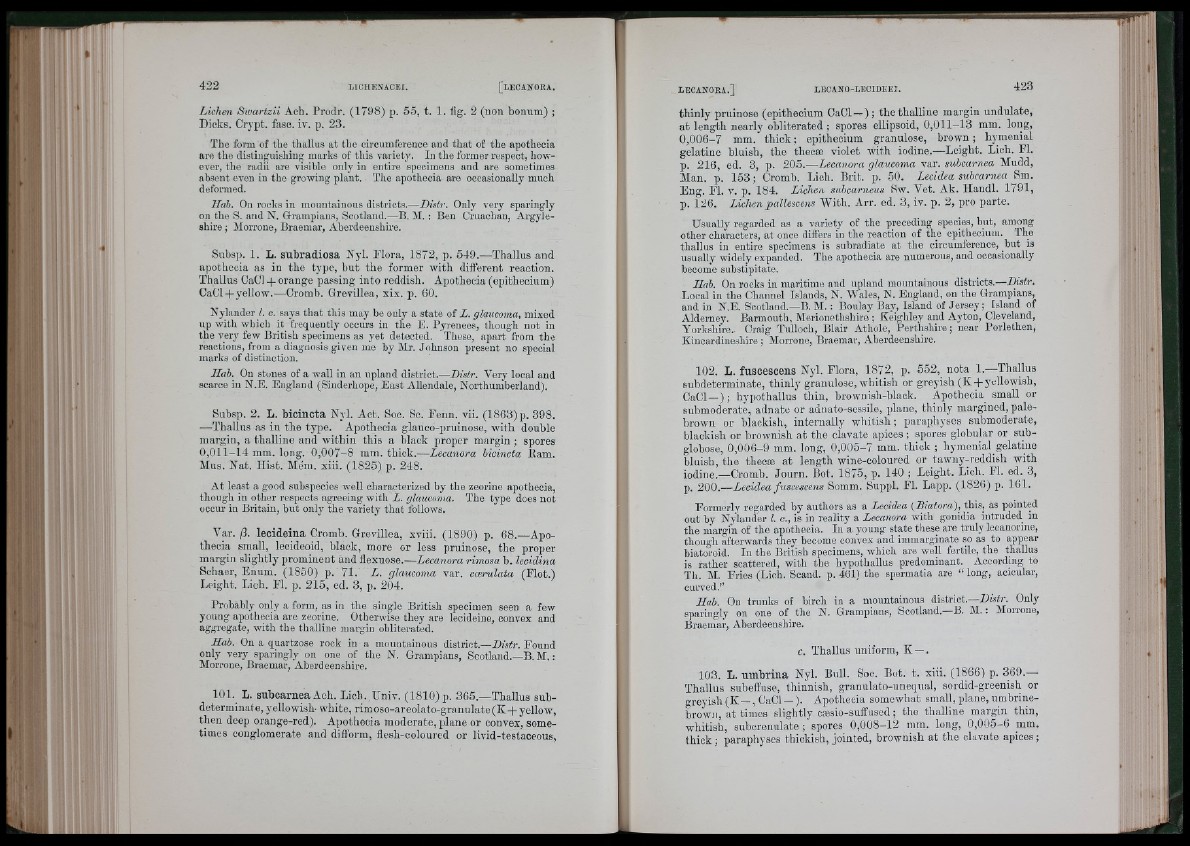
i
Lichen Swartzii Aoh. Prodr. (1798) p. 55, t. 1. lig. 2 (non boniim) ;
Dicks. Crypt, faso. iv. p. 23.
The form of the thallus at the circumference and th at of the apothecia
are the distinguishing marks of this variety. In tlie former respect, however,
the radii are visible only in entire specimens and are sometimes
absent even iu the growing plant. The apothecia are occasionally much
deformed.
Hah. On rocks in mountainous districts.—Histr. Only very sparingly
on the S. and N. Grampians, Scotland.—B. M. : Ben Cruachan, Argyleshire
; Morrone, Braemar, Aherdeeiisliire.
Subsp. 1. L. su b ra d io s a Nyl. Flora, 1872, p. 549.—Thallus and
apothecia as in th e type, b u t the former with different reaction.
Thallus CaCl + orange passing in to reddish. Apothecia (epitheoium)
CaCl + yellow.—Cromb. Grevillea, xix. p. 60.
Nylander Z. e. says tliat tliis may be only a state of L. glaucoma, mixed
up with which it frequently occurs in the E. Pyrenees, Uiough not in
the very few British specimens as yet detected. These, apart from the
reactions, from a diagnosis given me hy Mr. Johnson present no special
marks of distinction.
Hah. On stones of a wall in an upland district.—Histr. A'ery local and
scarce in N.E. England (Sinderhope, East Allendale, Northumberland).
Subsp. 2. L. h ic in c ta Nyl. Act. Soc. Sc. Fenn. vii. (1863) p. 398.
—Thallus as in th e type. Apotheoia glauco-pruinose, w ith double
margin, a thalline and w ith in this a black proper m a rg in ; spores
0 ,0 1 1 -1 4 mm. long. 0 ,0 0 7 -8 mm. thiok.— Lecanora hicincta Ham.
Mus. Nat. H is t. Mem. xiii. (1825) p. 248.
At least a good subspecies well characterized by the zeorine apothecia,
though in other respects agreeing with L. glaucoma. The type does not
occur in Britain, but only the variety th at follows.
A'ar. p. le c id e in a Cromb. Grevillea, xviii. (1890) p. 68.—Apothecia
small, lecideoid, black, more or less pruinose, the proper
margin slightly prominent and flexuose.— Lecanora rimosa h. lecidina
Schaer, Enum. (1850) p. 71. L. glaucoma var. ccerulata (Flot.)
Leight. Lioh. Fl. p. 215, ed. 3, p. 204.
Probably only a form, as in the single British specimen seen a few
young apothecia are zeorine. Otherwise they are lecideine, convex and
aggregate, with the thalline margin obliterated.
Hab. On a quartzose rock in a mountainous district.—Distr. Found
only very sparingly on one of the N. Grampians, Scotland.—B. M .:
Morrone, Braemar, Aberdeenshire.
101. L. su h c a rn e a Aoh. Lich.,Univ. (1810) p. 365.—Thallus suhdeterminate,
yellowish- white, rimoso-areolato-granulate(K + yellow,
then deep orange-red). Apotheoia moderate, p lane or convex, sometimes
conglomerate and difform, flesh-coloured or livid-testaceous.
th in ly pruinose (epitheoium CaCl — ) ; the th allin e margin undulate,
a t length nearly obliterated ; spores ellipsoid, 0 ,0 1 1 -1 3 mm. long,
0 ,0 0 6 -7 mm. thiok ; epitheoium granulose, brown ; hymenial
gelatine bluish, the thecæ violet with iodine.—Leight. Lich. Fl.
p. 216, ed. 3, p. 205.—Lecanora glaucoma var. mbearnea Mudd,
Man. p. 153 ; Cromb. Lich. Brit. p. 50. Lecidea suhcarnea 8m.
Eng. Fl. v. p. 184. Lichen subcarneus 8w. Yet. Ak. Handl. 1791,
p. 126. Lichen pallescens AVith. Arr. ed. 3, iv. p. 2, pro parte.
Usually regarded as a variety of the preceding species, but, among
other characters, at once diilers in the reaction of the epithecium. The
thallus in entire specimens is subradiate at the circumference, but is
usually widely expanded. The apotheoia are numerous, and occasionally
become substipitate.
Hnb. On rocks in maritime and upland moimtainous districts.—Distr.
Local in the Channel Islands, N. AVales, N. England, on the Grampians,
and in N.E. Scotland.—B. M. ; Boulay Bay, Island of .lersey; Island of
Alderney. Barmouth, Meriouethshire ; Keighley and Ayton, Cleveland,
Yorkshire.. Craig Tulloch, Blair Athole, Perthshire; near Porlethen,
Kincardineshire ; Morrone, Braemar, Aberdeenshire.
102. L. fusceseens Nyl. Flora, 1872, p. 552, nota 1.—Thallus
subdeterminate, th in ly granulose, whitish or greyish (K + yellowish,
CaCl — ) ; hypothallus th in , hrownish-black. Apothecia^ small or
suhmoderate, adnato or adiiato-sessile, plane, thinly margined, pale-
brown or blackish, in ternally w h itish ; paraphyses submoderate,
blackish or brownish a t th e clavate apices ; spores globular or subglobose,
0 ,0 0 6 -9 mm. long, 0,0 0 5 -7 mm. thiok ; hymenial gelatine
bluish, th e thecæ a t len g th wine-coloured or tawny--roddish with
iodine.—Cromb. Journ. Bot. 1875, p. 140 ; Leight. Lioh. Fl. ed. 3,
p. 2 00.—Lecidea fusceseens Somm. Suppl. Fl. Lapp. (1826) p. 161.
Formerly regarded by authors as a Lecidea (Biatora), this, as pointed
out by Nylander I. c., is in reality a Lecanora with gonidia intruded in
the margin of the apothecia. Iu a young state these are truly lecanorine,
though afterwards they become convex and immarginate so as to appear
biatol-oid. In the British specimens, which are well fertile, the thallus
is rather scattered, with the hypothallus predominant. According to
Th. M. Fries (Lich. Scand. p. 461) the spermatia are “ long, acicuiar,
curved.”
Hab. On trunks of birch iu a moimtainous district.—DisZr. Only
sparingly on one of the N. Grampians, Scotland.—B. M. : Morrone,
Braemar, Aberdeenshire.
c. Thallus uniform, K —.
103. L. um h rin a Nyl. Bull. Soo. Bot. t. xiii. (1866) p. 389.—
Thallus subeffuse, thinnish, granulato-unequal, sordid-greenish or
greyish (K —, CaCl —). Apothecia somewhat small, plane, umbrine-
browii, a t times slightly cæsio-suffused ; th e thaUine margin thin,
whitish, suborenulate ; spores 0 ,0 0 8 -1 2 mm. long, 0 ,0 0 5 -6 mm.
th io k ; paraphyses thiokish, jointed, brownish a t th e clavate apices;